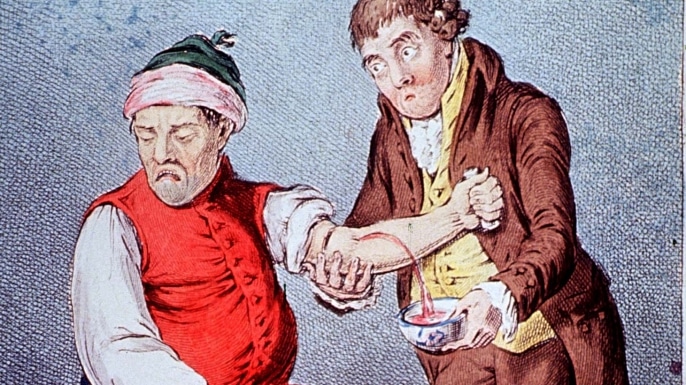Funtabulously Frivolous Friday Five 345
Just when you thought your brain could unwind on a Friday, you realise that it would rather be challenged with some good old fashioned medical trivia FFFF, introducing the Funtabulously Frivolous Friday Five 345
Question 1
What eponymous sign is shown in the portrait below by Marcus Gheeraerts the younger?

Reveal the funtabulous answer
Queen Anne’s sign
Lateral truncated (or thinning) eyebrows signifying hypothyroidism.
The problem is, there isn’t actually any evidence that Queen Anne of Denmark actually had hypothyroidism.
Proponents for this diagnosis point to the fact her neck looks larger, thinning eyebrows, historical reports of increasing lethargy, heavy menstruation, complaints of arthritis, depression and leg swelling. Her cause of death at the age of 44 was stated as ‘dropsy’ – aka oedema, which potentially could have been from myxoedema.
However, Queen Anne had fair eyebrows, it was the fashion to truncate them. It has been said she also had the ‘finest neck’ in the kingdom so anyone doing her portrait may have wanted to accentuate this feature. She certainly doesn’t have clear signs of a goitre. Equally, historical reports show that she was far from lethargic and was very active in courtly engagements.
Alas, we will never know, but it shows while looking at portraits to improve our observation skills in medicine we are still at the mercy of fashion and political and artistic trends of the time. We are only seeing what the artist wishes us to see and drawing of pathology, particularly in Royalty wouldn’t have led to a long career.
So where did the eponym Queen Anne’s sign come from – we don’t know. It’s an anonymous eponoym. However, if you are keen on your eponyms, perhaps more correctly it should be called the Sign of Hertoghe. The sign is named after the Belgian Internist Eugene Ludovic Christian Hertoghe (April 5, 1860–January 3, 1928), who was a native of Antwerp, and was the first pioneer in thyroid function research.
The Sign of Hertoghe can also be seen in atopic dermatitis and lepromatous leprosy.
Reference:
- Bardes, CL, Gillers D and Herman AE. Learning to look: developing clinical observation skills at an art museum. Medical Education. 2002;35(12):1157-1161
- Furdell EL. Eponymous, anonymous: Queen Anne’s sign and the misnaming of a symptom. Journal of Medical Biography. 2007. https://doi.org/10.1258/j.jmb.2007.06-13
- Sign of Hertoghe – Wikipedia – accessed 15th Aug 2022
Question 2
What condition first described in the 1850s, known then as Bell’s Mania, is better known as today? A few clues for you; at that time, it had a 75% mortality rate; it disappeared until 1985 from the literature; people have used tasers to help; it is not recognised as an ICD 10 diagnosis.
Reveal the funtabulous answer
Excited delirium.
I’m hoping I gave you enough clues that you were not thinking of a patient with unilateral facial paralysis. Yes, this is a different Dr Bell. Dr Luther Vose Bell (1806 – 1862) was an American psychiatrist who first described a group of patients with delusions similar to schizophrenia but with an added sympathomimetic state and fever when he was a hospital superintendent for McLean Asylum near Boston.
Excited delirium was not a top diagnosis until the resurgence of drugs in our populations. Fortunately, mortality rates are lower, but it is still a disorder to be feared. For political reasons, it has not been formally recognised as a diagnosis in some organisations due to legal implications. We have all witnessed taser use or physical restraints in excited delirium not going well. Equally, the use of sedation has resulted in patient death. Be aggressive but very cautious in a true excited delirium.
Reference:
- Mash. DC. Excited Delirium and Sudden Death: A Syndromal Disorder at the Extreme End of the Neuropsychiatric Continuum. Frontiers in Physiology. 2016;7:435
Question 3
Who is most commonly associated with the following aphorism?
He who knows syphilis knows medicine.
Reveal the funtabulous answer
Sir William Osler, although he never said this exact quote, see below for his actual quotes (thanks, Mike).
At the turn of the 20th Century, syphilis was so common every physician needed to know myriad clinical presentations. Indeed there was even a subspeciality of ‘syphilology’. Thankfully due to the advent of penicillin, its occurrence is rarer, but numbers are climbing.
Syphilis ‘quotes’
The above aphorism is most commonly associated with Osler but did not appear in any of his publications, speeches, books of quotations or aphorisms…but that is copy and paste history for you…
Know syphilis in all its manifestations and relations, and what remains to be learned will not stretch the pia mater of a megalocephalic senior student.
Osler 1897
Know syphilis in all its manifestations and relations, and all other things clinical will be added unto you.
Osler 1906
There is no organ in the body, nor any tissue in the organs, which syphilis does not invade: and it is therefore manifestly difficult to speak, at least at all concisely, of the pathology of the disease; just as it is almost impossible to describe its clinical symptoms without mentioning almost every symptom of every disease know
Osler 1907
Question 4
Which video game is the first to be approved by the FDA for the treatment of ADHD? That’s right, you can actually prescribe a video game!
Reveal the funtabulous answer
Evaluated in over 600 children with ADHD across 5 clinical studies. EndeavorRx improved objective attention in children with ADHD ages 8-12. Both parents and children reporting approximately 70% improvement in attention.
Want to fly around different worlds as an alien? See for yourself…
Reference:
- Kollins SH, DeLoss DJ, Cañadas E, Lutz J, Findling RL, Keefe RSE, Epstein JN, Cutler AJ, Faraone SV. A novel digital intervention for actively reducing severity of paediatric ADHD (STARS-ADHD): a randomised controlled trial. Lancet Digit Health. 2020 Apr;2(4):e168-e178.
- Kollins SH, Childress A, Heusser AC, Lutz J. Effectiveness of a digital therapeutic as adjunct to treatment with medication in pediatric ADHD. NPJ Digit Med. 2021 Mar 26;4(1):58.
Question 5
Imagine you are on shift and a dialysis patient comes into resus. Imagine said patient is acutely short of breath. You quickly determine they have pulmonary oedema with whizz clinical skills and ultrasound in hand. Their BP is 180/80, agressive nitrates and NIV is started. They are anuric so bang goes any frusemide as an option. Your friendly nephrologist can’t do dialysis for another 12 hours. Its looking like you might need to intubate the patient as after 60 mins of agressive medical management you can’t get their sats above 85% and despite NIV they are getting tired.
What antiquated treatment could be implemented to avoid an intubation while waiting for dialysis?
Reveal the funtabulous answer
Phlebotomy

In one study, 21 haemodialysis patients in respiratory distress underwent phlebotomy (approx 200-300cc) and 17 dramatically improved avoiding intubation and emergent dialysis. In fact some of these patients were able to get their dialysis up to 24 hours later. Just an extra trick to add to your tool box. Bring on the leeches!
Reference:
- Eiser AR, Lieber JJ, Neff MS. Phlebotomy for pulmonary edema in dialysis patients. Clin Nephrol. 1997 Jan;47(1):47-9
…and Finally
If you ever wanted to win your wife’s weight in beer, why not enter the wife carrying world championships in Finland:

FFFF
Funtabulously Frivolous Friday Five
Dr Neil Long BMBS FACEM FRCEM FRCPC. Emergency Physician at Kelowna hospital, British Columbia. Loves the misery of alpine climbing and working in austere environments (namely tertiary trauma centres). Supporter of FOAMed, lifelong education and trying to find that elusive peak performance.
